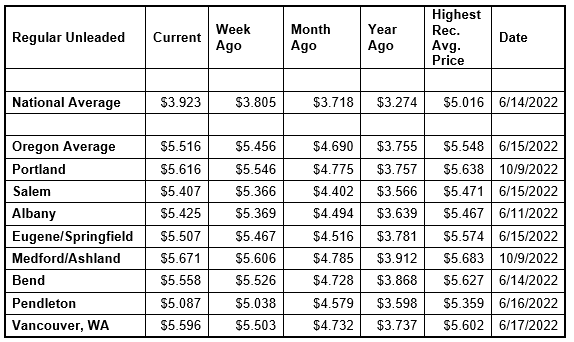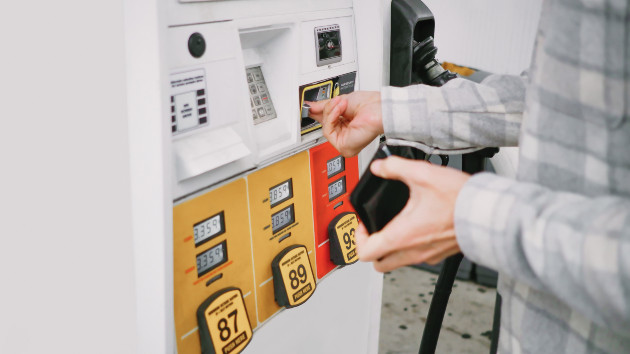Pump prices on the West Coast are finally settling down after three weeks of significant gains. Refineries in this region are coming back online after undergoing planned and unplanned maintenance. This is helping to ease the severe supply crunch. However, higher crude oil prices continue to put upward pressure on gas prices. For the week, the national average for regular adds 11 cents to $3.92 a gallon. The Oregon average climbs six cents to $5.52. Oregon went from having the fifth-largest weekly jump for a state last week to the 41st largest increase this week.

The Oregon average came within a penny of reaching a new record high this month when it got to $5.54 a gallon. It has decreased slightly since then. Both the national and Oregon averages hit record highs in mid-June, then declined for 14 consecutive weeks before rising again for the last three weeks. The national average reached its record high of $5.016 on June 14 while the Oregon average reached its record high of $5.548 on June 15.
“Pump prices on the West Coast skyrocketed after at least six refineries in California went offline or were operating at reduced capacity. This put a major dent in supplies in this region. Our pump prices shot up and also put upward pressure on the national average for gas,” says Marie Dodds, public affairs director for AAA Oregon/Idaho. “The improving refinery situation and the switch to winter blend fuel should help ease the upward momentum in gas prices, as long as crude oil prices don’t see significant gains.”
The change from summer blend gas to winter blend gas normally puts downward pressure on pump prices because winter blend gas is cheaper to produce. Summer blend fuel is more environmentally friendly than winter blend. It has a lower Reid vapor pressure, which means it is less volatile and doesn’t evaporate as quickly in hot weather. The switchover from summer- to winter blend can start on September 15 in most areas; however, in California the switch normally occurs on Oct. 31. This year, because of the supply issues, California Governor Gavin Newsom called for the switch to begin a month early.
Refineries typically perform maintenance in the spring and/or fall ahead of the seasonal switch. Most refineries in the U.S. are more than 50 years old. Some are more than 100 years old. Maintenance is necessary to keep refineries running smoothly.
Last week’s decision by OPEC+ to cut oil production by two million barrels a day has caused crude oil prices to rise back above $90 per barrel. Crude reached a recent high of $122.11 per barrel on June 8, and ranged from about $94 to $110 per barrel in July. In August, crude prices ranged between about $86 and $97. In September, crude prices ranged between about $76 and $88 per barrel. So far in October, crude has ranged between $83 and $93 per barrel.
Crude prices rose dramatically leading up to and in the first few months of Russia’s invasion of Ukraine. Russia is one of the world’s top oil producers and its involvement in a war causes market volatility, and sanctions imposed on Russia by the U.S. and other western nations resulted in tighter global oil supplies. Oil supplies were already tight around the world as demand for oil increased as pandemic restrictions eased. A year ago, crude was around $81 per barrel compared to $89 today.
Crude oil is the main ingredient in gasoline and diesel, so pump prices are impacted by crude prices on the global markets. On average, about 53% of what we pay for in a gallon of gasoline is for the price of crude oil, 12% is refining, 21% distribution and marketing, and 15% are taxes, according to the U.S. Energy Information Administration.
Despite rising pump prices, demand for gasoline in the U.S. increased from 8.83 million b/d to 9.47 million b/d for the week ending September 30. This is similar to last year at this time when demand was 9.43 million b/d. The increase may have been due to some prep ahead of Hurricane Ian as people fueled up before the storm.
Total domestic gasoline stocks decreased significantly by 4.7 million bbl to 207.5 million bbl. High gasoline demand, amid tight supply, has led to higher pump prices nationwide.
Quick stats
Oregon is one of 47 states and the District of Columbia with higher prices now than a week ago, and 32 states have double-digit increases. Delaware (+31 cents) has the largest weekly jump in the nation. California (-12 cents) has the largest weekly decline.
California ($6.29) has the most expensive gas in the country for the fifth week in a row and is the only state with an average above $6 a gallon. Six states, including Oregon, have averages at or above $5 a gallon. This week 13 states have averages at or above $4, and 37 states and the District of Columbia have averages in the $3-range.
The cheapest gas in the nation is in Georgia ($3.25) and Mississippi ($3.30). For the 92nd week in a row, no state has an average below $2 a gallon.
The difference between the most expensive and least expensive states is $3.04 which is extreme.
Oregon is one of 35 states with higher prices now than a month ago. The national average is 21 cents more and the Oregon average is 83 cents more than a month ago. Oregon has the third-largest monthly increase in the nation. California (+90 cents) has the largest month-over-month jump. New York (-25 cents) has the largest monthly drop. The average in Georgia is flat.
All 50 states and the District of Columbia have higher prices now than a year ago. The national average is 65 cents more and the Oregon average is $1.77 more than a year ago. This is the third-largest yearly increase in the nation. California (+$1.85) has the biggest yearly increase. Connecticut (+15 cents) has the smallest year-over-year increase.







